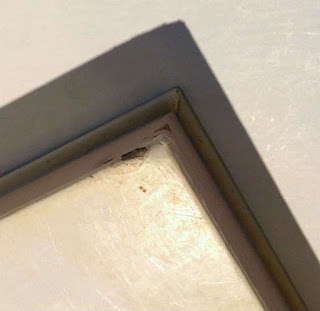I came across this book in my favourite second hand shop recently. At first sight it doesn't look very prepossessing - in fact it looks downright grungy. The glossy white cover is scratched, discoloured, stained and chipped and it is ever so slightly tacky to the touch, like a cookbook left out in the kitchen for too long. Ick!
Then you open it up to find glorious, clean, empty pages. I'm only guessing, but there might be around 200 leaves, which makes 400 pages in A4 size. This is the kind of journal I dreamt of owning back when I still kept written records of my reading. I've gone wholly digital now, so I'll have to find a different use for it. More about that below.
I can only speculate as to what this book was designed for, but the paper is thick and heavy and I'd like to imagine it to have been designed as a guest book (maybe for a convention or a company), sketchbook or journal rather than a scrapbook, because the binding is too tight to allow for many insertions. From the tackiness and the nature of the discolourations and stains on the cover I think someone bought it with the intention of writing recipes in it, kept it in a kitchen for years and never did anything with it and then donated it to the charity shop.
This stamp is the only clue as to the provenance of the book. Eurolitho seems to be a publishing and printing company based in Italy.
I'll probably use it as a commonplace book and/or sketch book and/or journal. It's tempting to put it in my little motorhome to use as a log book and journal for my travels in the car, but it's big and heavy and space-saving is a concern, so probably not.
I'm having fun thinking up ways to make the cover more attractive. I might draw on it with Sharpies or cover it with stickers or decoupage, or simply make a nice dust cover for it. I might even go all out and make a sculpted leather cover for it. But I'll start by giving it a gentle scrubbing to see if the stains will come off.
Then you open it up to find glorious, clean, empty pages. I'm only guessing, but there might be around 200 leaves, which makes 400 pages in A4 size. This is the kind of journal I dreamt of owning back when I still kept written records of my reading. I've gone wholly digital now, so I'll have to find a different use for it. More about that below.
I can only speculate as to what this book was designed for, but the paper is thick and heavy and I'd like to imagine it to have been designed as a guest book (maybe for a convention or a company), sketchbook or journal rather than a scrapbook, because the binding is too tight to allow for many insertions. From the tackiness and the nature of the discolourations and stains on the cover I think someone bought it with the intention of writing recipes in it, kept it in a kitchen for years and never did anything with it and then donated it to the charity shop.
This stamp is the only clue as to the provenance of the book. Eurolitho seems to be a publishing and printing company based in Italy.
I'll probably use it as a commonplace book and/or sketch book and/or journal. It's tempting to put it in my little motorhome to use as a log book and journal for my travels in the car, but it's big and heavy and space-saving is a concern, so probably not.
I'm having fun thinking up ways to make the cover more attractive. I might draw on it with Sharpies or cover it with stickers or decoupage, or simply make a nice dust cover for it. I might even go all out and make a sculpted leather cover for it. But I'll start by giving it a gentle scrubbing to see if the stains will come off.
 |
| There is a bit of chipping - but nothing that can't be fixed. This chip, for example, will disappear under a metal corner. |



Comments